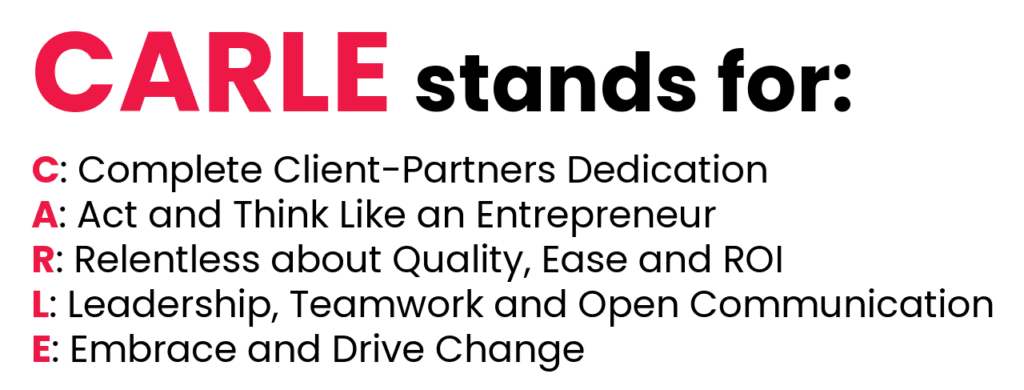Getting Company Values off the Wall and Into Practice!

Andy Buting, CEO of Tulip Media Group, got my attention recently when he spoke about the prominence of values in his day-to-day workplace.
Andy’s values are structured using an acronym, CARLE, the company’s original name as well as the first letters of his children’s names.
Side Note: Acronyms are important if you have more than three values, especially if they are part of phrases, as people struggle to remember more than three things on-the-fly.

Here’s the next critical bit: The words and short phrases are not enough to embed values in your culture. Such words and phrases are open to personal interpretation, which works well when you want people to connect their own personal values with the company values; however, to embed these into your workplace as a decision-making tool, you need to define them so people can see what they look like in practice.
Plus, when you define them, people can be recognized for living these values at work.
Let’s me give you an example from CARLE:
C: Complete Client Partners Dedication
- Realize the success of our Client-Partners is our success.
- Go above and beyond every day.
- If it’s within our means logistically – make it happen!
- The answer is always “YES – Now what is your question?” (A Forbes.com published quotation by Micah Solomon pertaining to the customer experience.)
- When we learn about an issue, we own the issue.
Notice that these are written in a manner that will have meaning for team members and are not formal. Everything is written in plain English. Forget the corporate language when it comes to describing values. The important thing is they are memorable, and you can communicate them with ease.
In fact, in the case of Tulip Media, each item reads like a catch phrase and is relatively easy to recall on its own.
My personal favourite is: When we learn about an issue, we own the issue. Personal accountability is empowering and builds capacity. Great stuff!
From the Wall to the Meeting Space
So far, these values are still “on the wall”. They have been selected, described and defined. So now begins the real work! In my experience, this is where most companies stop.
Some companies will then insert them into their performance management program and ask managers to assess each team member against living the values as well as their goals and objectives. This may sound like a good idea; however, companies often stop short of aligning them to their rating scales. What does a 1 look like for Client-Partners Dedication? What about a 5 and everything in between? Others use a Pass/Fail system. Again, clarity is required.
Rather than jumping to inserting values into Performance Management Systems, there is another step that is needed before this can be truly effective: socialize the values with your team. What does this mean? It means figuring out how to reward and recognize those who are living the values and coming up with creative ways to keep the values front and centre in ways that demonstrate they are decision-making tools across the company.
At Andy’s workplace, one of his practices does both!
Andy's Practice: A Team Meeting Agenda Item
At Tulip Media, during their weekly team meeting, they kick off with the presentation of the Core Values (CV) Trophy! The team gathers, virtually, around an online dashboard that shows, from left to right, the following: Quarterly Sales Goals, Sales Metrics and Core Values Trophy, placed above the Weekly Task Plan.
There is also a fun twist: Each team member has an avatar that is displayed on the dashboard. The CV Trophy sits above the avatar that is presenting that meeting.

The presentation is simple: The person with the trophy above their avatar received the trophy at the previous team meeting. They received it because another team member observed them living one of the company values and shared the story. When you receive the trophy, it is then your turn to notice when another team member is living the values over the course of the next week.
Then, at the next team meeting, you present the trophy to them. In this manner the trophy circulates through the team.
When Andy was describing this to me, he noted that this is not something he has to “manage”. The team knows what to do and they make it happen. He is part of the team and will receive and give the trophy but he does not drive this agenda item.
In my experience, when this happens, it is because the activity is viewed by the team as truly meaningful. It also gives them a sense of progress. These are the two necessary ingredients to creating a passionate workplace.
Values and How They Support Passion
“Passion happens within us when we experience our work as highly meaningful and we experience the pace of progress as fulfilling.” (Spark’d)
Meaning + Progress = Passionately Engaged
On our survey we just don’t ask if people know the company values. We ask if people believe in the company values. Knowledge does not necessarily provide meaning. Belief does.
Storytelling as a Crucial Ingredient
The stories captured and told by team members can range from small gestures that are meaningful to big wins. Both are important to recognize. One team member might share that they were impressed by how someone managed a mistake made by a supplier, showing empathy and helping to solve the issue, even though the error was made by someone else. (When we learn about an issue, we own the issue.)
On another occasion, someone might recognize the tremendous effort another team member made to secure a deal, going above and beyond normal sales protocols by helping the client clarify their strategic objectives and plans.
In both cases, these stories help calibrate what the values mean within the context of this organization’s purpose as well as its goals. Over time, people deepen their understanding of the core values and, most importantly, build this understanding together.
Connecting Values to Decision Making
These stories also connect the values to day-to-day decision making.
- Do I decide to support the supplier through correcting the mistake or do I say, “It’s not my responsibility” and wait until they fix it?
- Do I decide to help the client, even if it goes beyond my typical duties, in service of not just the sale but the relationship?
Knowing our values in life and in work helps us navigate our day. We make hundreds of decisions every day and being well versed in your company values will help you make decisions with more ease and confidence.
In summary, the simple process of passing along a virtual trophy at a team meeting, when it is grounded in storytelling and facts, embeds values into the day-to-day work of a team, imbuing it with meaning and celebrating progress, which goes a long way to sustaining passion at work!
It's Okay to Inherit Values
I would like to add one final note: your current team does not have to be the ones who create the values.
A company’s values, if aligned to the organization’s purpose, will stay relevant for many years. Organizations sometimes spend too much time refreshing values that are perfectly relevant, rather than investing the time and effort in helping people connect to the values. Employees will adopt and believe in values set by previous leadership or teams, if they see them in practice and understand their importance in realizing the company’s vision and team’s aspirations.
Summary of Getting Company Values Off the Wall and Into Practice!
- Create an acronym for your core values if there are more than three.
- Ensure you describe what the values look like in practice in plain English.
- Create a team activity that involves everyone in recognizing others who live the values.
- When you recognize, tell the story, so everyone can learn what the value looks like in practice.
- Share the ownership of this activity. Ensure that it is not “owned” by the manager but is shared by the entire team.
- Make it fun! This is a form of celebration and should not be heavy and serious. Fun can be meaningful, if you are celebrating something that is inherently meaningful and progresses the company.
- Highlight how the story demonstrates core values as decision-making tools.
- Do the above before you insert them into your performance management processes.
- Resist the urge to refresh values; instead, reflect on how well the current values serve the organization’s vision and mission and, if aligned, focus on recognizing them in practice.
To learn more about how to measure your team’s passion at work and the strength of your values, book a demo with Spark’d!

